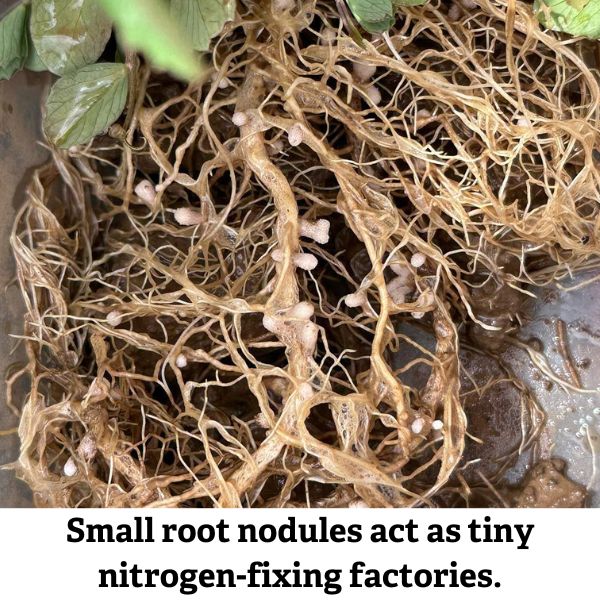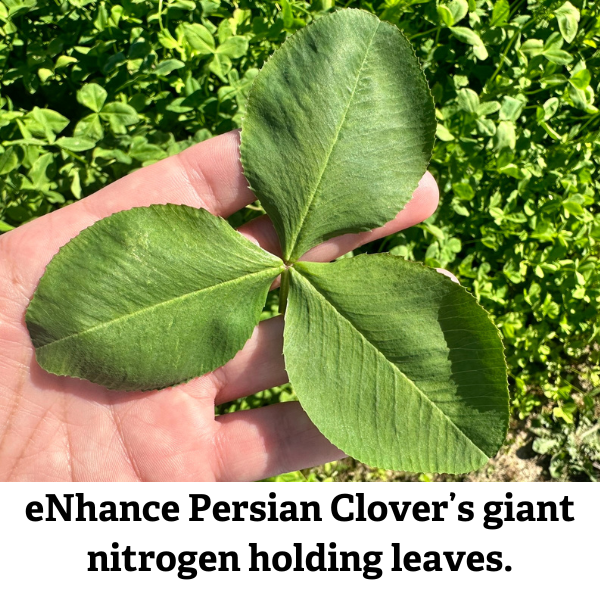If you’re using legume cover crops to increase your soil’s natural nitrogen, proper termination timing is key to getting the maximum nitrogen benefit.

It’s widely known that legumes have a symbiotic relationship with soil bacteria known as rhizobia. When clover seeds germinate, their roots release compounds that attract and allow infection by rhizobium bacteria. Each legume species can associate with several different rhizobia, but not all rhizobia fix nitrogen at the same rate. To get optimal nitrogen additions from the addition of your legume, they must be properly inoculated with specie specific rhizobia.

The rhizobia enter the root hairs and migrates through plant tissues. In response, the plant forms small nodules along its roots to house the bacteria. These nodules act as tiny nitrogen-fixing factories. The root nodules persist for the legume’s lifetime, fixing atmospheric nitrogen while the plant is actively growing and photosynthesizing. The plant stores this nitrogen in the above-ground plant biomass, the greater the biomass the greater the nitrogen stored. Some species can store more nitrogen in a pound of biomass than others. When the legume dies or is terminated, the plant biomass decay releases the nitrogen fixed by the rhizobia into the soil for use by subsequent crops.

Professor Dr. John Jennings of University of Arkansas System Division of Agriculture, Little Rock writes, “Most of the N is found in the top growth of the plant with a smaller amount in the crown, roots and nodules. Estimates for perennial legumes show that abut 75-80 percent of the plant’s N content is in the top growth. Texas A&M research showed that in crimson clover (a winter annual clover) about 90 percent of the total N was in the top growth and only 10 percent in the roots.” Citation
Understanding that a significant portion of the fixed nitrogen is transported up into the clover’s above-ground biomass – the stems, leaves, and flowers gives us a greater understanding of how to maximize the N from the cover crop. FIXatioN Balansa Clover, Frosty Berseem Clover, and eNhance Persian Clover are known for substantial nitrogen additions because of their abundant leafy growth.

Indiana regenerative farmer, Rick Clark, noticed a vast difference of available nitrogen when extending his growing days of FIXatioN Balansa Clover. “I was blown away to see how the nitrogen content had doubled with the clover from June 4 to June 8! By letting it grow just four more days, the cover crop biomass was able to put on an additional 140 lbs of nitrogen, 40 lbs phosphorus, and over 200 lbs of potassium. That was roughly $595 worth of savings per acre,” says Clark.
The stored nitrogen stays trapped until the clover begins to decompose after termination. To capture the maximum nitrogen contribution from the above-ground growth, terminate FIXatioN Balansa Clover, Frosty Berseem Clover, and eNhance Persian Clover at bloom stage. Terminating at this stage allows you to capture as much of the above-ground nitrogen stored in the biomass as possible. As the plant matter breaks down, it will slowly release the sequestered nitrogen for use by your subsequent crops.

With proper management, legumes can be excellent nitrogen sources and extremely beneficial cover crops for improving soil fertility in your cropping systems. Follow along with GO Seed’s Director of Research, Dr. Shannon Cappellazzi, to see how different termination methods and timing can affect the nitrogen availability for the subsequent cash crop with their series, “Dude, Where’s My N?”.
NOTE: Be sure to terminate clover cover crops before the seeds become reproductive. While some reseeding can be beneficial for perpetuating the clover stand, terminating too late runs the risk of heavy reseeding that can allow the clover to become a weed problem for future crops.

